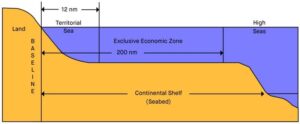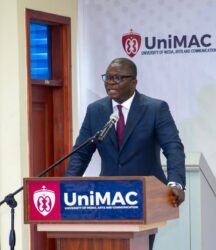“…Some people still think they are powerful enough to think international waters should be theirs.” UN Secretary-General António Guterres (Lisbon, June 2022)
Marine Biodiversity Beyond National Jurisdiction (BBNJ) refers to all living organisms in the high seas, including marine species, microorganisms and plants. The high seas cover two-thirds of the ocean and are extraordinarily diverse in terms of biodiversity. According to The Guardian, barely 1.2 percent of the high seas are protected. There are pockets of laws that regulate the protection and sustainable use of marine biodiversity in Areas Beyond National Jurisdiction (ABNJ); namely, the high seas, under the existing 1982 UN Convention on the Law of the Sea (UNCLOS). Article 192 of the 1982 UNCLOS is the most significant regulation of Marine Biodiversity Beyond National Jurisdiction (BBNJ). The article underscores the responsibility of all states to safeguard marine biodiversity on the high seas, and ensure that it is not depleted or destroyed in any manner.
The UN has proposed a new International Legally Binding Instrument (ILBI) to address the gap in regulations under the 1982 UNCLOS, and to provide more clarity to the regime of conservation and sustainable use of Marine Biodiversity Beyond National Jurisdiction (BBNJ). The BBNJ treaty, also referred to by others as the ‘Treaty of the High Seas’, is still being negotiated by UN member-states; and it is anchored on four (4) main strategic pillars: Marine Genetic Resources (MGRs) – including benefit sharing; Area-Based Management Tools – including Marine Protected Areas; Environmental Impact Assessments (EIAs); and Capacity Building and Technology Transfer.
The historical antecedents of the high seas cannot be overlooked when dealing with such a revolutionary international legal instrument that is manifestly under intensive negotiation. These historical realities as well as the principle of equity should serve as the blueprint for the development of the new legal order.
In the early history of the law of the sea, the ocean was dominated by two prominent theories; Hugo Grotius proposed Mare Liberum, which argued for the freedom of the high sea, so that all states – whether coastal or landlocked – had unfettered access to the high seas, particularly for navigation. The opposing theoretical position was Mare Clausum, espoused by John Selden, who contends that the high seas are under the sovereignty of a state, and are inaccessible to other states. It should be observed that proponents of the Mare Liberum theory were successful in cementing the concept of freedom on the high seas from the 17th to the 20th centuries.
After World War II, the maritime zones – which consisted of 3 nautical miles of territorial waters of coastal states and the high seas – were amended due to the economic and military interests of coastal states. Consequently, the territorial sea from the coastal baseline was codified to be 12 nautical miles, and the Exclusive Economic Zones (EEZ) to be 200 nautical miles from the coastal baseline from which the territorial sea was measured. The areas beyond the Exclusive Economic Zones (EEZ) formed the high seas.

The existing 1982 UNCLOS regime, under Article 87, upholds the principle of freedom on the high seas. This implies that all states, whether coastal or landlocked, have the right to freely navigate, fish, overfly, undertake maritime scientific research, and install underwater cables and pipelines. These activities, however, must be conducted with due regard for the rights of other states and other applicable laws of the 1982 UNCLOS.
It is worth noting that before the 1960s, the high seas included the seabed, ocean floor, and subsoil, which allowed all states the ability to use the high seas as they saw appropriate under the principle of freedom of the high seas. However, many developing states felt disadvantaged because of economic inequality and technological imbalance, and demanded fairness and equality in seabed exploitation. These concerns were addressed in Article 136 of the 1982 UNCLOS, which stipulates that the seabed and its resources within the Areas Beyond National Jurisdiction (ABNJ) are the Common Heritage of Mankind, implying that they belong to all states and must benefit all humanity.
This effectively was to end the monopoly of developed states and their huge private firms. It began a new era of shared gains of exploiting the seabed within the Areas Beyond National Jurisdiction (ABNJ) for the benefit of all humanity. Thus, the Seabed Authority was mandated to redistribute proceeds emanating from the exploitation of the seabed in the ABNJ to all states.
It is imperative to observe that even though some maritime experts believe that Marine Biodiversity Beyond National Jurisdiction (BBNJ) is a Common Heritage of Mankind, it has not found expression in the 1982 UNCLOS regime. The Common Heritage of Mankind only applies to non-living organisms, such as seabeds within the Areas Beyond National Jurisdiction (ABNJ), as shown in the preceding paragraph. This is primarily due to the lack of information and technological know-how at the time the first UNCLOS was enacted.
Marine biodiversity in the high seas is a global common that must be protected for the sake of humanity. The high seas are beyond national jurisdiction, and there are currently no sufficient international regulations in place to preserve and sustain living organisms in this area. This means that developed states and private firms with adequate economic resources and technological capabilities may do whatever they want in these areas without any consequences for their businesses or profits. They can use destructive fishing methods, pollute, and endanger the marine environment and exploit marine species without any repercussions.
The fifth (5th) of five (5) sessions of the Inter-Governmental Conference (IGC5), convened in August 2022 at the UN Headquarters in New York to finalise the BBNJ Treaty, failed to achieve its goal, with no agreement signed into a treaty, owing primarily to a lack of concurrence among member-states. The main protagonists in the impasse were the developed states – principally the US and EU member-states, on one end, and the G77 – which is made up of developing states including the African Group, on the other.
The African Group, along with the rest of the G77, were frontal in their demand that the marine biodiversity in Areas Beyond National Jurisdiction (ABNJ) must reflect the principle of the Common Heritage of Mankind. I suppose they were inspired by Article 136 of the 1982 UNCLOS, which underpins the principle of the Common Heritage of Mankind for non-living organisms in the ABNJ. However, their counterparts from the US and EU member-states, on the other hand, argued that the BBNJ Treaty should mirror the principle of freedom of the high seas. These seemingly parallel positions are fundamental to the architecture of the BNNJ Treaty.
The US and EU member-states initially refrained from committing to the profit-sharing principle for Marine Genetic Resources (MGRs) with all member-states. However, in shifting slightly in position, they have now resolved to limit the requirements that the BBNJ Treaty may impose on them to share the benefits and profits that may accrue to them for the exploitation of the MGRs with all states. Marine Genetic Resources (MGRs) are a cash cow for developed states and their huge private firms, especially those in the pharmaceutical and biotechnology industries. The West seeks to safeguard its economic interests by any means necessary. The African Group and the G77 have taken strong exception to this inequality by the Western states, and demanded equity and fairness in the benefits that will be derived from the Marine Genetic Resources (MGRs) together with capacity-building and marine technology transfer to disadvantaged states.
There is a comparable divide between the two blocs in terms of Environmental Impact Assessment (EIA). While the US and the EU advocate for a modest standard for Environmental Impact Assessment (EIA) to minimise international monitoring of their operations, the G77 – including the African Group – are advocating for stricter regulation to protect the marine ecosystem in the BBNJ.
Western states are steadfast in their pursuit of economic self-interest over the common good of all humanity. Their spirited advocacy for high seas freedom and expanded provisions on Environmental Impact Assessment (EIA) as a foundation for the drafting of the BBNJ Treaty is a means of securing unlimited access to the high seas to further their pillage. This is attributable to their technological advancement and financial muscle, which would provide them with the leverage to plunder the marine ecosystem in Areas Beyond National Jurisdiction (ABNJ) while avoiding strict international scrutiny.
The G77, especially the African Group, must demonstrate the highest integrity and fidelity in the face of seeming imperialism by the West. The marine ecosystem in Areas Beyond National Jurisdiction is relatively unexplored; therefore, ceding to the whims and caprices of the West will likely have far-reaching consequences for the present and future generations.
These are economic resources that may accelerate the growth of developing economies. Justice must be done, not merely seen to be done.
The Common Heritage of Mankind’s principle is the most formidable proposition that will guarantee the protection of marine biodiversity, ensure peace on the high seas, and the equitable distribution of Marine Genetic Resources (MGRs) to all of humanity rather, than just the developed few.
The collective ownership of ocean resources on the high seas should awaken the conscience of all UN member-states as they work to resolve the impasse in their next cycle of inter-governmental negotiations.
The writer is the Executive Director, Institute for African Maritime Development










